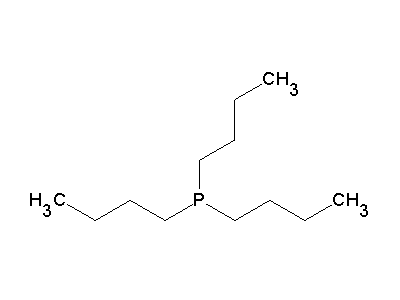Appearance Colorless oily liquid Molar mass 202.32 g/mol Autoignition temperature 168 °C (334 °F; 441 K) | Formula C12H27P Density 820 kg/m³ R-phrases R11 R17 R20/21/22 R34 R38 | |
 | ||
Main hazards Stench, Flammable, Corrosive | ||
Tributylphosphine is the organophosphorus compound with the formula P(C
4H
9)
3. Abbreviated or PBu
3, it is a tertiary phosphine. It is an oily liquid at room temperature, with a nauseating odor. It reacts slowly with atmospheric oxygen, and rapidly with other oxidizing agents, to give the corresponding phosphine oxide. It is usually handled using air-free techniques.
Contents
Preparation
Tributylphosphine is prepared industrially by the addition of phosphine to butene: the addition proceeds by a free radical mechanism, and so the Markovnikov rule is not followed.
Tributylphosphine can be prepared in the laboratory by reaction of the appropriate Grignard reagent with phosphorus trichloride although, as it is commercially available at reasonable prices, it is rare to have to perform the small-scale preparation.
Reactions
Tributylphosphine reacts with oxygen to give the phosphine oxide:
2 PBu3 + O2 → 2 OPBu3Because this reaction is so fast, the compound is usually handled under an inert atmosphere.
The phosphine is also easily alkylated. For example, benzyl chloride gives the phosphonium salt:
PBu3 + PhCH2Cl → [PhCH2PBu3]ClTributylphosphine most commonly encountered as a ligand in transition metal complexes. Tributylphosphine is also a common ligand for the preparation of complexes of transition metals in low oxidation states. It is cheaper and less air-sensitive than trimethylphosphine and other trialkylphosphines. Although its complexes are generally highly soluble, they are often more difficult to crystallize compared to complexes of more rigid phosphines. Furthermore, the 1H NMR properties are less easily interpreted and can mask signals for other ligands. Compared to other tertiary phosphines, it is compact (cone angle: 136°) and basic (χ-parameter: 5.25 cm−1)
Use
Tributylphosphine finds some industrial use as a catalyst modifier in the cobalt-catalyzed hydroformylation of alkenes, where it greatly increases the ratio of straight-chain aldehydes to branched-chain aldehydes in the product mixture. However, tricyclohexylphosphine is even more effective for this purpose (although more expensive) and, in any case, rhodium catalysts are usually preferred to cobalt catalysts for the hydroformylation of alkenes.
It is the precursor to the pesticide 2,4-dichlorobenzyltributylphosphoniumchloride ("Phosfleur").
Odor
The main laboratory inconvenience of tributylphosphine is its strongly unpleasant smell. Manipulations must be carried out in an efficient fume hood, and glassware which has come into contact with the compound must be decontaminated before leaving the hood. The manipulation of large quantities requires specific precautions to prevent the release of the vapour into the environment.
Hazards
Tributylphosphine is moderately toxic, with an LD50 of 750 mg/kg (oral, rats).
